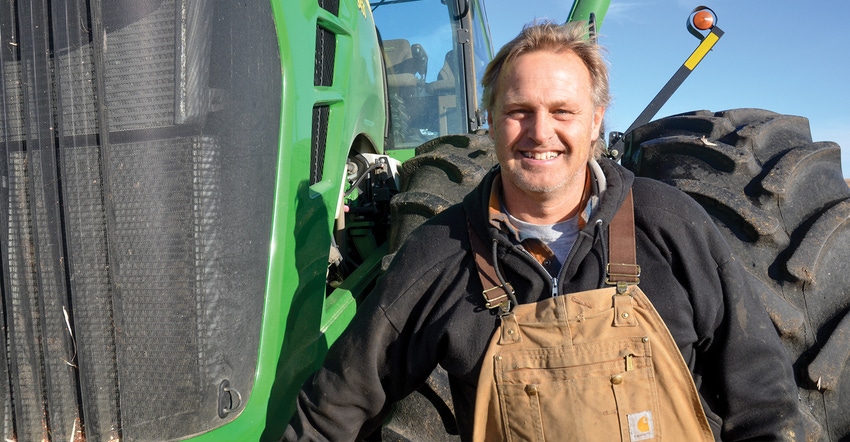
Corn acres have expanded north from the traditional Corn Belt. The crop has gained a strong following in North Dakota, where shorter maturities have thrived on fields once filled with spring wheat and barley.
In addition, ethanol plants, good highways and access to railroads have given these farmers ready markets for the crop, which produced more than 500 million bushels for the state in 2016.
While corn has been grown in North Dakota for decades, primarily in the southeast corner, recently fields have been planted up to the Canadian border and in the West, where rain is less frequent.
“I am surprised how far north corn has gotten, and they are getting phenomenal yields. I don’t see anything but more acres being grown in North Dakota,” says Clark Coleman, who farms near Bismarck in the central part of the state.
In addition to corn, Coleman grows canola, soybeans, sunflowers and winter wheat. He also has a cow-calf herd that grazes on his pastures.
“If you compare our yields to Iowa and Illinois, we don’t have those types of yields. A lot of guys average 150 to 160 bushels of corn. For the most part, we are pretty happy with that,” he says.
Larger supplies ahead?
North Dakota is probably not going to replace Iowa, Illinois or Nebraska in the corn rankings, but the increased production there as well as in Minnesota and even Canada implies supplies of the grain will remain large for years to come. Even if one or two of those states have a bad harvest, there will be others to make up the difference.
“We have undergone a wet cycle in eastern North Dakota. It has made corn and soybeans more attractive,” says Joel Ranson, Extension agronomist at North Dakota State University. “We have added a few more frost-free days. I don’t think that is the deciding factor, but it is a favorable factor particularly for corn.”
Other factors that have had corn and soybeans displace wheat and barley include new varieties of quick-maturing corn, high corn and soybean prices several years ago that had farmers switching to and staying with those crops, and for corn, the construction of at least five ethanol plants in the state.
Coleman has two ethanol plants nearby that take his corn. While he admits changes in climate have contributed to corn’s growing popularity, the shorter-maturity hybrids have probably been a greater factor. “You couldn’t buy a corn 10 to 15 years ago that was less than a 90-day maturity. You can get corn into the 70-day maturity now. That is what we are seeing in the northern part of the state,” he says.
North Dakota’s corn yields may not match those in the Midwest, but the lower land costs make it financially viable. Iowa farmers pay on average about $230 an acre in cash rent, while in North Dakota they pay $50 to $130. At those rates, North Dakota farmers can make 150-bushel-per-acre corn work at $3.50 a bushel.
Demand Needed
While corn and soybean production has expanded north, the question now being asked is will there be demand for it? Experts who monitor global population trends say there will be a need for corn and other food crops as that population grows, but it may take a few years for that demand to develop.
“If the world can get its economic growth going a little faster, then we can consume our way out of this bear market. But that is a big if,” says Gary Blumenthal, president of World Perspectives, a Washington-based agriculture consulting firm.
The world population is forecast to top 8 billion in 2030 from the current 7.4 billion and surpass 9 billion in 2050. Most of that growth is expected in central and southern Asia and in Africa.
Bruce McCarl, ag economist at Texas A&M University, says crop production may not increase fast enough to meet that need. As an example, he says annualized growth in corn production has slowed since 1970. “If the rate of productivity growth is smaller than the population growth, then the markets are going to be better for farmers,” he says.
Blumenthal is more confident that the food will be there. “The experts say that by 2030 we will not have enough food. I do not think that is true,” he says. Farmers have found ways to improve supplies and demand. “I think it take the same tenacity going forward that occurred in past decades. Farmers are businessmen, and all businesses face opportunities and risk.”
McCarl says studies indicate crop production, particularly corn and soybeans, will continue to migrate north in the next 25 years as the country slowly warms.
“Farmers on the southern edge of where corn is produced and on the northern edge where it is produced are the ones who are going to see adjustments,” he says. “Across southern Indiana, in Arkansas and Tennessee and surrounding areas, corn will become less desirable, and cotton and sorghum will be more desirable.”
In the north, such as North Dakota, corn and soybeans will continue to displace wheat. “We show that the overall effect of climate change is beneficial for crops, because currently we have more acres in the U.S. limited by cold than are limited by heat.”
About the Author(s)
You May Also Like




